I just covered one of the i.MX 8M systems-on-module last Friday with Variscite DART-MX8M SoM, but Variscite is not the only company about to launch such modules, and today I’ll have a look at Compulab CL-SOM-iMX8 system-on-module based on the same NXP i.MX 8M dual or quad core Cortex A53 processor.
Compulab’s SoM comes with up to 4GB RAM, 64GB eMMC flash, an optional WiFi & Bluetooth module, as well as optional support for Ethernet, LVDS, analog audio, and more. Contrary to most competitors, the company has also made an habit of releasing detailed pricing the basic configuration and per option.
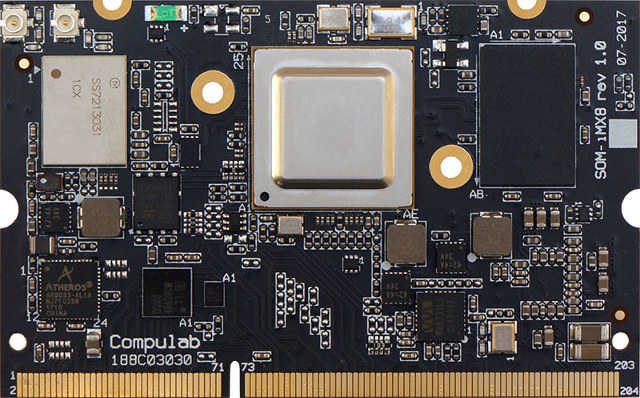
But first, let’s go through the specifications:
- SoC (one of the other)
- NXP i.MX8M Quad quad core Arm Cortex-A53 processor @ 1.5GHz with Arm Corex-M4 real-time core, Vivante GC7000Lite GPU supporting OpenGL ES 3.1, Open CL 1.2 and Vulkan
- NXP i.MX8M Dual dual core Arm Cortex-A53 processor @ 1.5GHz with Arm Corex-M4 real-time core, Vivante GC7000Lite GPU supporting OpenGL ES 3.1, Open CL 1.2 and Vulkan
- System Memory – 1 to 4GB LPDDR4
- Storage – 4GB to 64GB eMMC flash
- Connectivity
- Optional WiFi 802.11a/b/g/n/ac WiFi & Bluetooth 4.1 BLE (Broadcom BCM4356 chipset)
- Optional Gigabit Ethernet Atheros AR8033 PHY
- Audio – Optional Wolfson WM8731L audio codec
- 204-pinedge connector exposing the following interfaces:
- Display
- HDMI 2.0a up-to 4096 x 2160 @60Hz
- LVDS up-to 1920 x 1080 @60Hz via on-module DSI to LVDS convertor
- 4-lane MIPI-DSI up to 1920 x 1080 @60Hz
- 24-bit Parallel RGB up to 1600 x 1200
- Touchscreen Capacitive touch-screen support through SPI and I2C interfaces
- Camera – 4-lane MIPI-CSI interface
- Networking – 1x 10/100/1000Mbps Ethernet
- Audio
- Analog stereo output, stereo input and microphone support
- Up to 4x I2S / SAI, S/PDIF input/output
- PCIe – PCIe x1 Gen. 2.1, optional extra PCIe x1 Gen. 2.1
- USB – 2x USB3.0 dual-role ports
- Serial – Up to 4x UART
- Up to 1x MMC/SD/SDIO
- Up to 2x SPI, Up to 3x I2C, Up to 4x general purpose PWM signals
- Up to 90x GPIO (multifunctional signals shared with other functions)
- Display
- Debugging – JTAG debug interface
- Misc – RTC Real time clock, powered by external battery;
- Supply Voltage – 3.35V to 4.2V
- Digital I/O – voltage 3.3V
- Dimensions – 68 x 42 x 5 mm
- Weight – 14 grams
- Temperature Range
- Operating – Commercial: 0° to 70° C; Extended: -20° to 70° C; Industrial: -40° to 85° C
- Storage – -40° to 85° C
- Relative humidity – 10% to 90% (operation); 05% to 95% (storage)
- Reliability – MTTF – > 200,000 hours; Shock 50G / 20 ms; Vibration 20G / 0 – 600 Hz
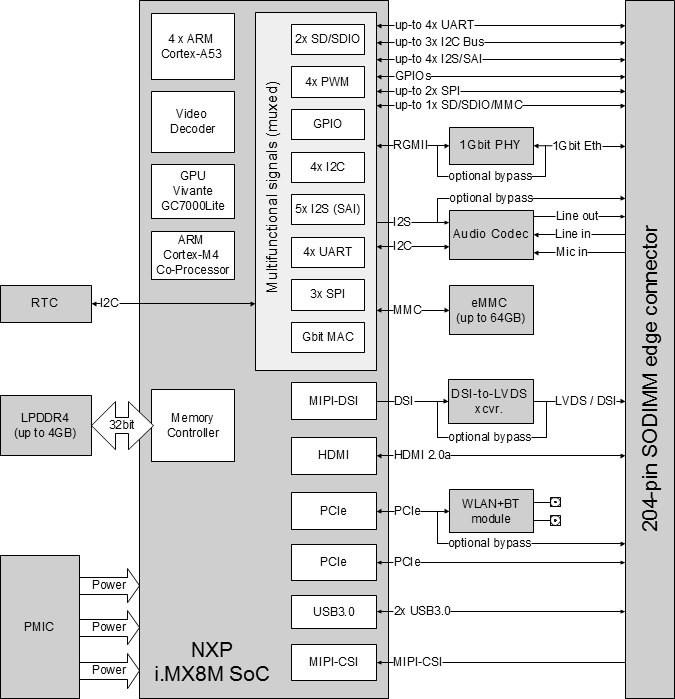
The company provides support for the Yocto Project with Linux mainline, and Android support is coming soon. SBC-iMX8 Evaluation Kit can be used to kickstart development with SOM-iMX8-C1500Q-D2-N16-E-A-WB-H module (quad core version with 2GB RAM, and 16GB flash, Ethernet, Audio, Wireless module, and heat dissipation plate), SB-iMX8 carrier board, a WiFi antenna and cable, a serial port cable, a USB cable and adapter, as well as a 12V power supply. The company also provides 12-month technical support for the kit.
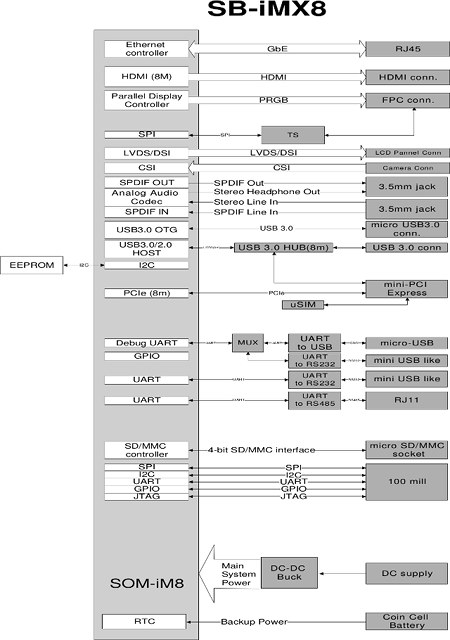
The SoM and devkit have not been formally launched (early product announcement), and I could not find a photo of the carrier board, nor the specifications in readable form, but the company has already released the schematics – from which I extracted the block diagram above -, PCB layout, and Gerber files for it, and it seems to pretty much expose all features from the SoM, as it should. [Update: photo of the kit included below
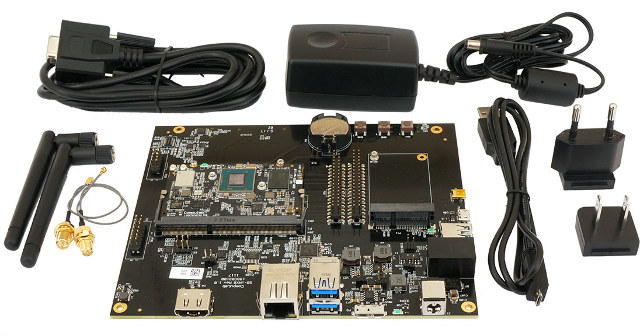
It’s unclear whether the SoMs are available now, but they should be soon, with 10-year longevity. As mentioned in the introduction the company also released pricing with the most basic model SOM-iMX8-C1500D-D1-N4 (dual core, 1GB RAM, 4GB storage, no other option) will sell/sells for $68 for 1k-unit price, and option pricing are shown below.
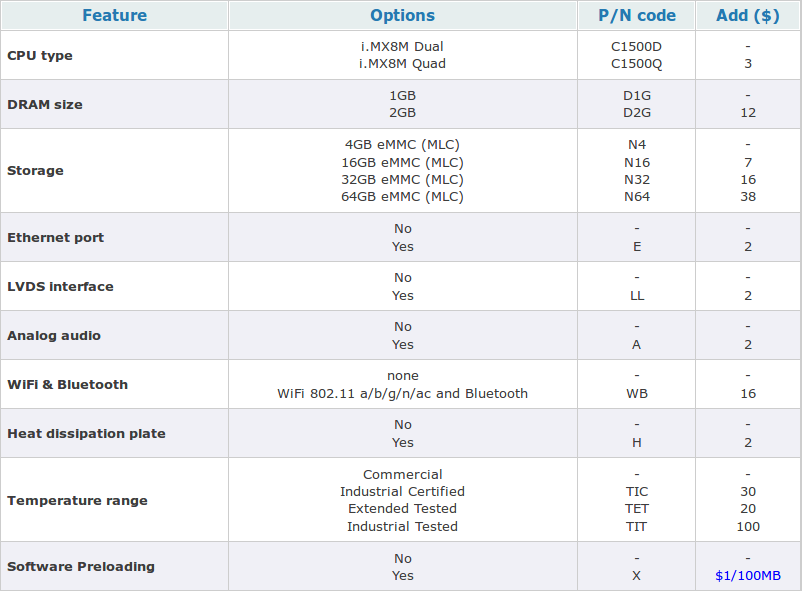
Price also fluctuates based on order quantity, and for example, the price for one sample is 2.5 times more expensive, while for 10K order, unit price is reduced by 5%. Visit the SoM and SBC product pages for more details, including initial hardware and software documentations, and further pricing info. The development kit is sold for $415.

Jean-Luc started CNX Software in 2010 as a part-time endeavor, before quitting his job as a software engineering manager, and starting to write daily news, and reviews full time later in 2011.
Support CNX Software! Donate via cryptocurrencies, become a Patron on Patreon, or purchase goods on Amazon or Aliexpress




just give me a normal friggen board 😛
@bantoto masabo sigola
In that case, get a WandPi 8M board 🙂
You may already know, but for people who don’t systems-on-module are for people who plan to design products in low quantities hundreds to thousands (sometimes tenth of thousands) and don’t want to spend engineering resources working on the complex hardware and software part of the board. Instead they design a baseboard (aka carrier board), and plug the SoM into it, also leveraging the work done on the low level part of the software by the SoM company.
In the case of Compulab, it looks like they will also help you check your baseboard’s schematics, and help with LCD drivers. In theory, you should also be able to upgrade with to the next generation SoM easily, but there’s no real dominating standard for SoM, companies often roll them own, although there are some standards (EDM, Q7, SMARC…), which expands the choice a bit.
My problem is more with the iMX8 vs the Allwinner H6. The chips are almost identical except for the MIPI camera/display. But the iMX8 is $40 and the H6 is $5.
On the plus side the iMX8 software is way, way, way better than Allwinners and it actually works. NXP is a heavy open source participant and it shows in their software quality.
@Jon Smirl THE IMX6 when it first came out also had very good software but it wasnt 40$+ . I hope it will come down in price
The iMX CPUs never go down much in price. What is more likely is another version with some features removed and a lower price point.
If Allwinner could get their software act together and sign up some US distributors they’d make huge inroads in the US. But that never seems to happen. I don’t know why they can’t take the very simple first step of keeping their code on public git servers. Last I heard about that was a claim that their license with Google prevented that. I think they are misunderstanding their license from Google; only non-released versions of Android need to be kept private. Once they are released it is ok to publish. After release, Google themselves puts the code up on the public AOSP servers. All Allwinner needs to do is publish their changes to the AOSP code.